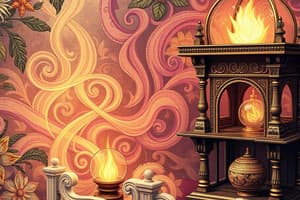Podcast
Questions and Answers
What are the key characteristics of metals according to the text?
What are the key characteristics of metals according to the text?
What is the classification of elements into metals and non-metals based on?
What is the classification of elements into metals and non-metals based on?
How are basic oxides different from amphoteric oxides?
How are basic oxides different from amphoteric oxides?
Which statement is true about alloys?
Which statement is true about alloys?
Signup and view all the answers
What is the process known as that involves extracting metals from their ores?
What is the process known as that involves extracting metals from their ores?
Signup and view all the answers
What happens when metals above hydrogen in the Activity series come in contact with dilute acids?
What happens when metals above hydrogen in the Activity series come in contact with dilute acids?
Signup and view all the answers
What is the purpose of galvanisation?
What is the purpose of galvanisation?
Signup and view all the answers
Why is pure iron not used in its pure state?
Why is pure iron not used in its pure state?
Signup and view all the answers
Which of the following is true about stainless steel?
Which of the following is true about stainless steel?
Signup and view all the answers
What happens to the properties of iron when it is alloyed with a small amount of carbon?
What happens to the properties of iron when it is alloyed with a small amount of carbon?
Signup and view all the answers
What is an alloy?
What is an alloy?
Signup and view all the answers
How does alloying affect the properties of metals?
How does alloying affect the properties of metals?
Signup and view all the answers
Why are metals high up in the reactivity series obtained by electrolytic reduction?
Why are metals high up in the reactivity series obtained by electrolytic reduction?
Signup and view all the answers
What happens to the metals in the thermit process due to the large amount of heat evolved?
What happens to the metals in the thermit process due to the large amount of heat evolved?
Signup and view all the answers
Why can't carbon reduce the oxides of highly reactive metals like sodium, magnesium, and calcium?
Why can't carbon reduce the oxides of highly reactive metals like sodium, magnesium, and calcium?
Signup and view all the answers
Which process is used to join railway tracks or cracked machine parts?
Which process is used to join railway tracks or cracked machine parts?
Signup and view all the answers




